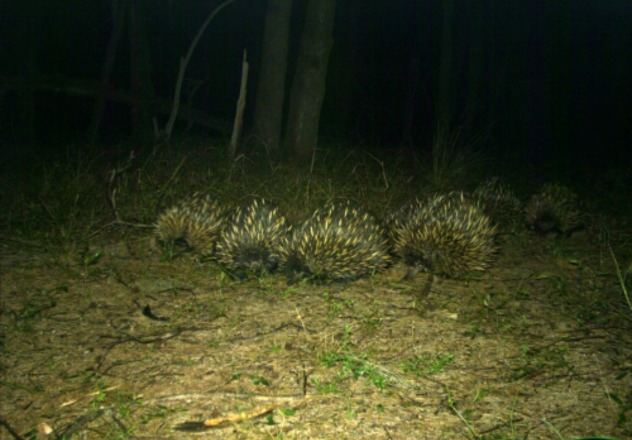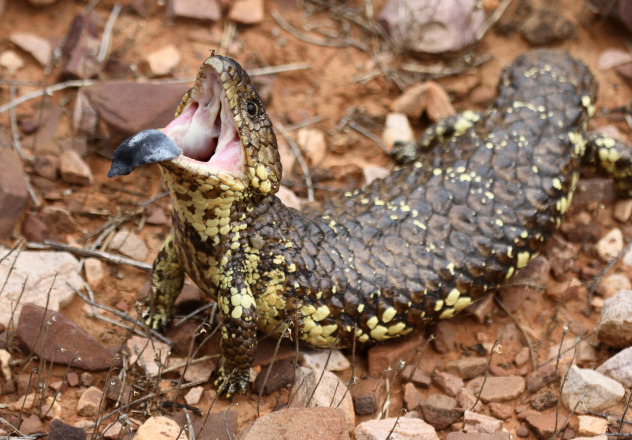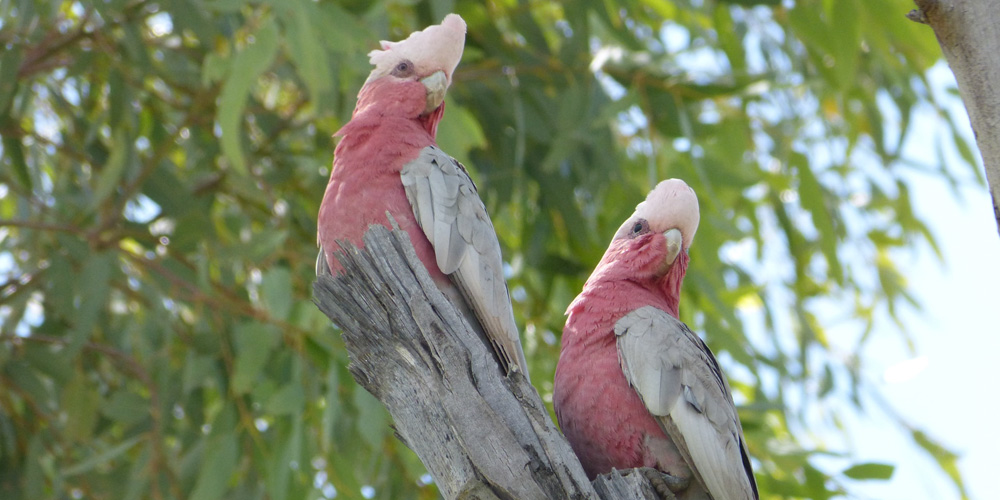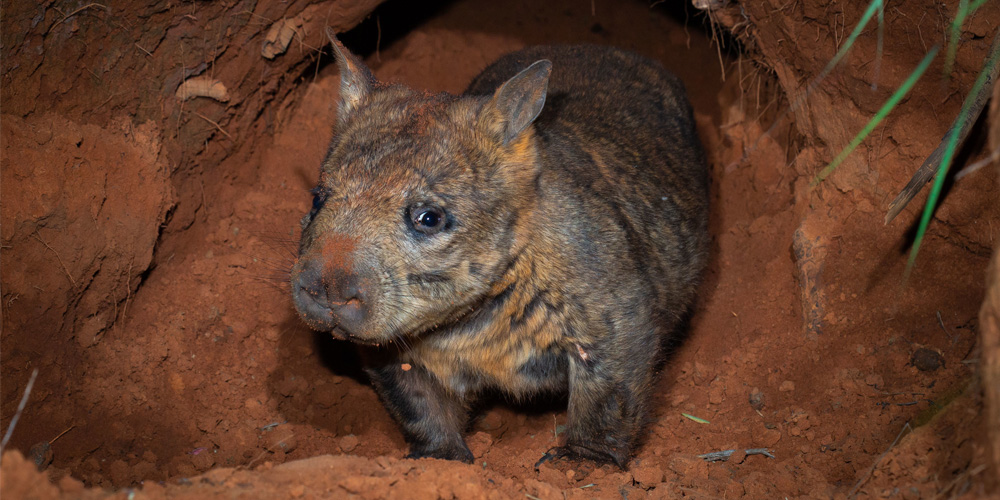From busting out their best dance moves to patiently waiting for ‘the one’, the mating rituals of Australian wildlife are as unique and varied as the species themselves. While love among some is intense and fleeting, others prefer a more…bachelor lifestyle… remaining on their own until the time is (fleetingly) right. Some species are even known to mate for life, affectionately raising families together every year, often at the same nesting sites.
This Valentine’s Day, we’re taking a closer look at the unique methods Australia’s native animals use to attract a partner.
Echidnas – Suitors, please form an orderly line
Echidna courtship is a love story of determination and commitment. Male echidnas form an orderly line behind a female, creating what is known as an ‘Echidna train’. Composed of a female in front releasing very alluring pheromones, trailed by a conga line of bachelors, an Echidna train can have as many as 11 males shadowing the females every move.

When it is mating time, another unusual behaviour occurs – the creation of a mating trench. When the female decides she is ready to mate, she partially buries her front legs and head into the soft dirt at the base of a tree or bush. The males start digging a trench around the female, with the female in the centre like a trophy on display.
If only one male is remaining in her train, the mating trench will be simple and straight. However, if there are several males, the trench becomes a large doughnut-shaped ring that can be up to 20 cm deep. The males then go head-to-head to push each other aside until only one remains with the female, impressing her with his devotion.
Shingleback Skinks – Return to Love
Sometimes referred to as the ‘faithful lizard’, Shingleback Skinks are the only known monogamous reptile species in the world. They can live for up to 30 years in the wild and for most of the year live alone – but stay in close proximity (about one square kilometre) to their long-term partners using scent trails. Their partner bond is quite strong and each year they meet up with their significant other during breeding time.

Shingleback breeding happens between September and November. The ‘meet up’ is a tender moment to witness, with the male showering his mate with ‘kisses’ all over her body. They then spend 6-8 weeks together before actual mating takes place. After the breeding season, the two part ways and will meet again at the same time next year. The female will give birth to two or three live young the following March or April.
Occasionally ‘divorces’ occur when a small male is displaced by one that is larger.
Sugar Glider: Pocket-sized love bugs
Sugar Gliders are happiest when they are getting love from – and giving love to – somebody else. They are very social animals and live in family groups, with multiple adults accompanied by the young from that season. Active at night, they spend the day sleeping in cuddle puddles in a nest made of leaves in tree hollows.

Mating occurs in July and August, and just 16 days later two babies are born. Sugar Gliders commonly give birth to twins, which remain in the pouch for just over two months. They then leave the nest to forage for food, usually with their mother. If conditions are favourable Sugar Gliders may produce more than one litter in a year.
Both Sugar Glider parents engage in parental care of their offspring. This arrangement allows one adult to keep the young warm in the hollow while the other parent is out foraging for food.
Peacock Spiders – Just Dance
What can a peacock spider do to impress a female when faced with mating or being killed? Show her your killer dance moves! These tiny dancers from the genus Maratus grow to be about 5mm in body length and range in colour from deep-dark browns to sandy blonde. Males are characterized by their colourful abdomen or opisthosomal flaps that they use as a ‘fan’ during courtship, displaying violets, jades and iridescent patterns in an elaborate dance of life and death.
Another important part of the male peacock spider’s courtship is the rhythm and beat behind the moves – caused by the fan dance’s vibrations. They also raise their third pair of legs, showing a brush of black hairs with white tips, using them in a clapping motion to attract the female’s attention and waving them in time to the vibrations.
However, his moves may not win her over. If the swaggering male fails to seduce his would-be lover, she may well eat him.
Galah: lifetime lovers
Also known as the Rose-breasted Cockatoo, Galah form permanent pair bonds which can span their entire lifetime of up to 50 years. They are a very social and affectionate species and will spend most of their time together in pairs, eating, cleaning, and playing together.

Galah will usually nest in Gum trees in hollows or holes. Bonded Galah pairs will continue to return to the same nest site every year, with both parents working together to get the nest ready for the eggs by lining it with soft eucalyptus leaves.
During the breeding season, males will put on a display for their female companion by strutting, bobbing and waving their heads and raising their crest, giving soft calls, and also clicking their bill.
Northern Hairy-nosed Wombat: Live-in lovers, but only short-term
There is limited information available on the behaviour of the critically endangered Northern Hairy-nosed Wombats. There are only 315 individuals remaining in two population pockets, but they are incredibly hard to study, as they tend to keep to themselves, spending a lot of time underground in their burrows and only emerging at night to feed.

Each wombat has their own burrow, which they either design and bulldoze themselves or renovate after a previous tenant has moved out. These burrows are marked with urine, cube-shaped dung, and scratches – a welcome mat of sorts – that lets other Wombats in the area know that this burrow is occupied.
However, it is these expansive underground mansions (the largest mapped burrow contained more than 90 metres of tunnels and six entrances!) that, during mating season, become a home for more than one. The arrangement is only temporary though, and by the time the gestation period of 21 days is over, the housemate has moved out.
Solitary they may be, but Northern Hairy-nosed Wombats are monogamous, and will only breed with the one partner each season.
Support Australian Wildlife Conservancy's work and safeguard the future of Australia's native species
Donate now